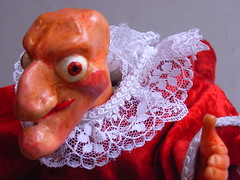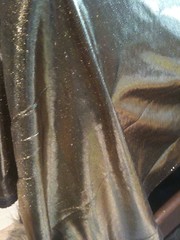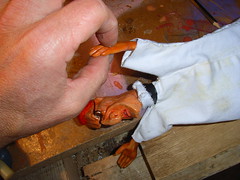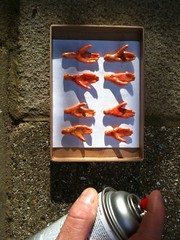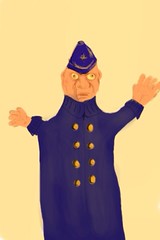The processes involved when I make stuff: sculpting, programming, electronics, carving, moulding, etc. Mostly puppets, automata, sculpture, occasionally furniture, interactives, food, etc. Usually fairly detailed and image-led. Please reuse any ideas, tips, thoughts and approaches.
Thursday, 31 December 2009
Friday, 6 November 2009
Saturday, 24 October 2009
Scientist reborn
Wednesday, 21 October 2009
Asymmetry
 Mr Punch naked, with hand in position that, if inserted, would produce the pose he is in.
Mr Punch naked, with hand in position that, if inserted, would produce the pose he is in.One thing I hadn't considered in advance was that thumb and forefinger are quite different in length (and fatness). This has some unexpected consequences.
It makes it hard for a two-fingered puppet to be used on either hand. The positioning of the holes through which the puppeteers fingers support the puppet's arms has to made to fit either a left hand or a right hand, but once made for one hand, the puppet cannot easily be used on the other...
Costume ponderings
Monday, 12 October 2009
Mr Punch in an old costume
Sunday, 11 October 2009
Mr Punch's body...
Tuesday, 6 October 2009
Skeleton problem may be solved
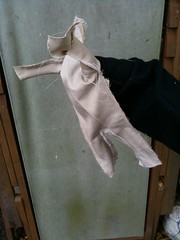
A-ha! This came to me on the train.
I have made a breakthrough in changing to a puppet with a full (if small) body with a separate sleeve attached horizontally.

This works by mounting the head on a rod (as a counter balance), and attachin the pivot to the costume inside the neck. This frees the two working fingers (thumb and forefinger) to move freely without being contrained by holding the rod
Friday, 2 October 2009
Puppet skeletons gone wrong?
The problem is that I am trying to adapt the traditional mount for three fingers, and not just trying to start from scratch with what works for two fingers. It is not working!
Using a trad glove puppet with the arm upright it is surprisingly uncomfortable and restrictive to move the puppet arm with the index finger.
I had a bit of an a-ha moment thinking about a steadicam mounting, which might be a better model than a glove puppet. How weird is that?
Wednesday, 30 September 2009
Tuesday, 29 September 2009
Thursday, 24 September 2009
Costumes
 Back in the newly cleared out shed with a new table for the sewing machine.
Back in the newly cleared out shed with a new table for the sewing machine.In the meantime, I lost a puppet head today, as it was purloined by a member of the public from a gilding workshop - shocking!
I had left it to be covered in (faux) gold leaf, and returned to find a schoolboy had taken it home. Farewell!
Wednesday, 16 September 2009
Scientist assembled
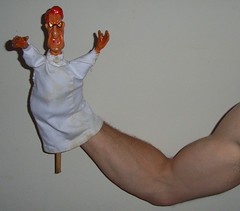
Scientist is now put together with his own hands and head, but no costume yet.
The final mounting shown uses a bamboo cane for mounting the head with the hands mounted on bamboo skewers. All three are glued into place using a hot glue gun.
This is a two fingered operation. i.e. it uses a thumb and forefinger in the two arms, but no finger in the puppet head. This method is not as symmetrical as using the standard three fingered glove operation (forefinger in head, thumb and second finger in the arms)
This is significant because the arms are not symmetrical, the puppet cannot be used on eather hand as effectively. This may mean considering each puppet as they will appear in the plot, so that the correct puppet is on the correct hand at any one time.
Assembling scientist body parts
Monday, 14 September 2009
Puppet body material
Sunday, 13 September 2009
Judy in another Judy's wig
Dead judy's wig
I was thinking I perhaps should only create puppets for Micro Mr Punch strictly from new materials, but decided that was not really in the theatrical spirit of reusing anything that was to hand.
I will post a pic of new judy in dead Judy's wig perhaps!
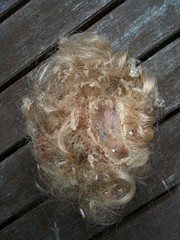
Dead judy's wig
Originally uploaded by rosemarybeetle
Wednesday, 9 September 2009
Tuesday, 8 September 2009
More hands ready to varnish
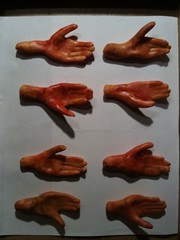
More hands ready to varnish
Originally uploaded by rosemarybeetle
Shot in the shed. Another batch of slightly eery hands...
Wednesday, 2 September 2009
Piccies from iPhone
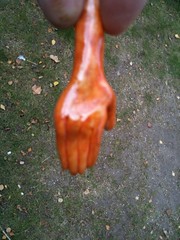
Piccies from iPhone
Originally uploaded by rosemarybeetle
This was a test of a rather tanned looking hand from my phone. Focus
is picking up the ground. Hmm...
Saturday, 22 August 2009
Wednesday, 19 August 2009
Colouring hands

The base colour is a mixture of Yellow Oche, Burnt Sienna and Alizarin Crimson Acyilic diluted to a thick but runny wash with a dash of washing up liquid squirted in to make it stick to the plasticky Fimo. (Amazing - makes water paint stick to water-resistant plastic!)
The Promakers are used to apply smudged washes of delicate colour and slightly sickening shades of green, pink, yellow, etc. This gives depth and richness.
Sunday, 16 August 2009
Smaller hands
Wednesday, 12 August 2009
Fimo hands
 I have been thinking about how best to make some hands, and Fimo is looking top candidate so far. Easy peasy to mould, but can be set hard - fabulous. This is rose coloured doll making Fimo, which is quite soft to work.
I have been thinking about how best to make some hands, and Fimo is looking top candidate so far. Easy peasy to mould, but can be set hard - fabulous. This is rose coloured doll making Fimo, which is quite soft to work.A new video of how to make hands using Fimo is available here:
http://www.youtube.com/watch?v=H8WmgD_HQDY
There is a similar setting modelling material that sets as an eraser - that is rubbery, but I have not tried that.
Monday, 10 August 2009
Hands
Monday, 3 August 2009
Lost in the woods
Friday, 31 July 2009
This is a test of the rod based skeleton, version 1. I am not convinced it allows enough subtlety of manipulation. The joint quality is also important, as slack in the joints, introduces lag and play in the movement between hand motion and motion transmitted to the puppet. Rigid rods also do not allow curling of arms or necks that direct finger control can do so well. Hmm...
Thursday, 30 July 2009
Talk to the Hand
Sunday, 19 July 2009
Costumes instead
 OK, I have had enough brainache trying to get to the bottom of rods versus fingers. It's times like this when you need to go sideways, so I am going to look at costumes instead...
OK, I have had enough brainache trying to get to the bottom of rods versus fingers. It's times like this when you need to go sideways, so I am going to look at costumes instead...How about this for a suit!
Hands or rods?
I have been struggling with making a rod based skeleton to mount the undersized puppets on, and which will allow their manipulation from below with one hand. The idea being to have a mechanism that transfers the hand movements via rods to the puppet above. This is proving tricky.
The rods and hinges being used are not really of a high enough quality. This introduces play in the transfer of the movements, which in turn causes a loss of subtlety.
Some options are:
- to carry on and perfect the mechanism by prototyping.
- abandon this and revert to using direct hand control
Monday, 6 July 2009
Saturday, 4 July 2009
Mr Plod
 Mr Plod
Mr PlodNot varnished, but pretty much finished policeman head.
Link to a step by step guide for this one on Instructables
Link to an animated version of the process on YouTube
Thursday, 2 July 2009
Further painting
Wednesday, 1 July 2009
Saturday, 20 June 2009
Mr Punch being painted

Mr Punch gets colour
Friday, 12 June 2009
Painting on raw papier mache
 White emulsion paint applied to raw papier mache on the Saleman puppet head. The cracks are caused by the water being absorbed from the emulsion too fast.
White emulsion paint applied to raw papier mache on the Saleman puppet head. The cracks are caused by the water being absorbed from the emulsion too fast.The remedy is to sand it and apply another coat. This can be repeated several times, although if you use too many coats, you can end up losing fine detail, as the paint tends to fill in grooves and cracks.
Saturday, 6 June 2009
Base coats for the cast
 The assembled cast. Well, their heads anyway.
The assembled cast. Well, their heads anyway.These are drying after having had their fourth base coat of white emulsion. Each coat of paint is lightly sanded to make it smooth. For hard to get at edges you can use wirewool. It is much more flexible for getting into details like eye sockets and nostrils!
Monday, 1 June 2009
Painting faces
 I am starting to paint the faces of the puppets. The first thing is to cover the plain brown heads with a base coat of white. I have always used normal domestic white matt emulsion paint for this, which is not only cheap, but does the job.
I am starting to paint the faces of the puppets. The first thing is to cover the plain brown heads with a base coat of white. I have always used normal domestic white matt emulsion paint for this, which is not only cheap, but does the job.However I thought I might try acrylic artist paint. This was to see if it was quicker between coats as acrylic dries very fast. It was not a good idea though. Acrylic holds brush stroke lines very visibly, which on a small puppet is a problem. It is also quite rubbery, and so the lines cannot be sanded down effectively between coats.
Sunday, 17 May 2009
Skeletons
 The small size of the puppets means that even with 2 fingers, instead of 3, it is not easy to get a hand inside without making the body look either too fat, or unduly distorted when working the puppet.
The small size of the puppets means that even with 2 fingers, instead of 3, it is not easy to get a hand inside without making the body look either too fat, or unduly distorted when working the puppet.This has meant going back to the idea of using an internal skeleton. Here is the first prototype being built.
Friday, 8 May 2009
Stencil and example body
 Here's a stencil and an example stitched from denim cut from it.
Here's a stencil and an example stitched from denim cut from it.Note - the template is asymmetric in this case. This needs to be considered when using material that has a different pattern on each side (e.g. a facing side, and backing side).
If you just cut out two pieces, and stitch together this will mean the face is not showing on one side.
To get round this, after drawing out one piece on your cloth, simply turn the stencil over before drawing out the next piece.
This will give two pieces that will sew 2 together with faces out on both sides. In this case the body uses plain cloth, so it doesn't matter!
Glove puppet pattern - the quick and easy way
Tuesday, 5 May 2009
Basic costume - version one

A first rough sew of a costume body for Mr Plod (or whatever the policeman may end up being called). This will be the basis for a generic cloth body, over which the proper character costumes can be fitted later.
This shows the stick where the finger would normally be. Using thumb and forefinger makes them a bit lopsided. arms are too big at present, but that can be adjusted in version 2...
Sunday, 3 May 2009
Friday, 1 May 2009
mechanisms
 I think that my attempts to use rods and hinges to transfer expression from fingertips to puppet-tips may be overkill.
I think that my attempts to use rods and hinges to transfer expression from fingertips to puppet-tips may be overkill.This drawing shows what may be a simpler way - just using 2 fingers instead of 3.
It still does not address the fact that a finger in the puppet's head gives a huge range of expression, but it does mean a simpler more direct connection between fingers and puppet movement than the rods and hinges probably could.




